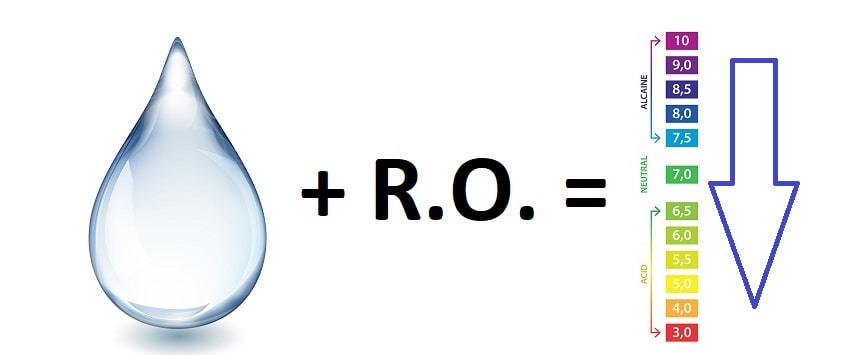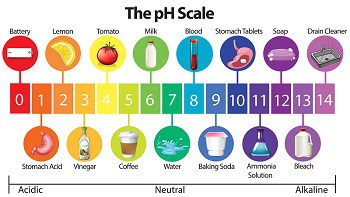I’ve had some people tell me that they were concerned about drinking reverse osmosis water because they heard that the process os reverse osmosis turns the water acidic and therefore it was unsafe to drink. Yes, it is acidic, but not to the point where it is harmful.
Does Reverse Osmosis Change pH? Since the process of reverse osmosis removes minerals in water that neutralize acid, reverse osmosis will reduce the pH of water because of the high amount of carbonic acid in the water after the water has been filtered.
This may sound a bit alarming, but the reduced pH of reverse osmosis water is still much less acidic than many other beverages that we drink every day. Let’s take a look at why reverse osmosis water is acidic, and how it compares to other things in our everyday diet.
What happens to waters pH when it goes through a reverse osmosis drinking water system?

As you may already know, reverse osmosis is the process of removing one thing from another. And in the case of a reverse osmosis drinking water system, we are removing dissolved solids from the water.
Some of these dissolved solids in the water like calcium, help to neutralize excessive acid in the water. Once these acid-neutralizing minerals are removed, the acid in the water will no longer be neutralized, and therefore the water will be acidic.
In other words, the pH of the water will be below 7.0 which is the pH of water that is considered to be neutral. Neither acidic or alkaline.
When reverse osmosis removes minerals that can neutralize the acid in the water, it becomes more aggressive and will react more easily with other substances that it comes into contact with.
When exposed to air, water will react with the gasses in the air which can change the characteristics of the water.
You probably are already familiar with the most common gas that contributes to reverse osmosis waters acidity once it comes into contact with air, it is known as carbon dioxide.
As water passes through a reverse osmosis membrane, unwanted minerals are rejected and rinsed away while the water molecules are able to pass through.
Dissolved gasses in the water are also able to pass through, and without acid-reducing minerals in the water, gasses like carbon dioxide in the air react with the reverse osmosis water to create carbolic acids that lower the pH of the water.
Just how much the pH of the water will drop once it has gone through the reverse osmosis process will vary on how much acid-reducing minerals are removed during the process, what the initial pH is, to begin with, and how much the water reacts with air.
The pH of the filtered reverse osmosis water will vary from one system to another, but in nearly all cases, the water will only be slightly acidic with a pH of 5.5 or above.
Is acidic reverse osmosis water dangerous?
Acidic water on its own can be considered unhealthy as it can corrode the plumbing and fixtures of a home and other substances like metals and minerals.
This may not seem to be an issue that you would think to be related to your health, but when acid corrodes metals that it comes into contact with, elements from the metals are carried along with the water and into the water that you drink.
But the water that comes out of a properly working reverse osmosis drinking water system, although acidic, has been filtered so that any unhealthy contaminants that the water may have accumulated should no longer be in the water.
As far as reverse osmosis water be unsafe to drink because of its acidity, a glass of reverse osmosis water may very well be the least acidic beverage that you drink in the course of your average day.

Let’s say that you start your day with a cup of coffee, much like the majority of us do. That cup of joe has a pH of about 4, which is much acidic than average reverse osmosis water.
Lunchtime comes and you go for a burger and a soda. Well, that soda has a pH of about 2.5, way more acidic than any reverse osmosis water that I have ever seen.
Mid-afternoon and you feel drained so you reach for a sports drink for a quick pick me up. That sports drink has a pH of about 2.9.
Work is finally over for the day, and a nice cold one sounds great. An average beer has a pH of 4.5.
So you see that even though reverse osmosis water is acidic, it is not nearly as acidic as most other beverages and overall, and it is much healthier for you than most regular tap water.
Also, your body is constantly balancing out its pH. The human body tends to hold a very constant pH of 7.4 which is comfortably non-acidic, but at the same time, not too alkaline.
As soon as any food or beverage makes contact with the saliva inside of your mouth, the pH is being balanced by your body. And even the most acidic or base foods are no match for your stomach which maintains a very constant pH of only 2.
Even chocolate is not excluded from the acidic food category. Chocolate is made from cocoa and has a high-fat content which makes its pH between 5 and 6. It may taste sweet, but it is more acidic than most reverse osmosis water.
How can I make my reverse osmosis water alkaline?
Ideally, the best way to reverse the acidic water effects of reverse osmosis water is to expose the water to minerals that neutralize the acid just like it was before it went through the reverse osmosis process.
But that doesn’t make any sense right!
Well, it does if we are only adding beneficial minerals back into the water and not dissolved solids that we don’t want in the water.
Calcium is a natural acid neutralizing mineral that is also beneficial to our health and well being. A calcium water filter can be easily used with reverse osmosis drinking water to help raise the pH of the water.
I recommend using an alkaline filter pitcher to not only raise the pH of your water, but it also allows you to keep water in your fridge so you have some cool and healthy water whenever you need it.
Conclusion:
The process of reverse osmosis itself does not change the pH of water, but the minerals that it removes from the water leave the water without the ability to become neutral.
Using an alkaline water pitcher can raise the pH of water, but does not actually change the alkalinity of the water. To raise the alkalinity of water you must add alkalinity powder to the water itself.
Using a Potassium Bicarbonate – Natural USP Food Grade Crystalline Powder like this one I found on Amazon, will naturally add alkalinity to your water so you can take advantage of potential alkalinity health benefits.


